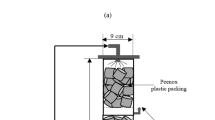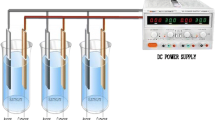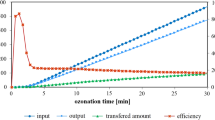Abstract
The removal of benzene, toluene, ethyl benzene, and xylene (BTEX) using the electrolytic oxidation or Fenton’s reaction has been studied. The value of current and pH value were shown to produce a significant effect on electrolytic oxidation of BTEX. More than 95% of BTEX could be removed at 500 mA current within 8 hours. In the case of Fenton’s reaction it was established that more than 95% of BTEX could be removed at pH 4 with an addition of hydrogen peroxide in the amount of 12 mg/dm3. The treatment cost based on electrolytic oxidation amounted to between $0.04 and $5.1 USD/m3. For Fenton’s reaction, the treatment cost was between $0.16 and $0.65/m3. The costs of electrolytic oxidation and Fenton’s reaction were similar to the cost of electrodialysis and cheaper than the freeze–thaw and evaporation; however, these costs were higher than for air flotation and the use of anoxic/aerobic granular activated carbon.
Similar content being viewed by others
References
Frost,T.K., Johnsen,S., and Utvik,T.I., Environmental Effects of Produced Water Discharges to the Marine Environment. http://www.olf.no/static/en/rapporter/producedwater/summary.html.
Powers, S.E., Hunt, C.S., Heermann, S.E., Corseuil, H.X., Rice, D., and Alvarez, P.J., The Transport and Fate of Ethanol and BTEX in Groundwater Contaminated by Gasohol, Critical Reviews in Environmental Science and Technology, 2001, vol. 31, no. 1, pp. 79–123.
Pruden, A., Sedran, M., Suidan, M., and Venosa, A., Biodegradation of MTBE and BTEX in an Aerobic Fluidized Bed Reactor, Water Science & Technology, 2003, vol. 47, no. 9, pp. 123–128.
Hayes, T. and Arthur, D., Overview of Emerging Produced Water Treatment Technologies, In The 11th Annual International Petroleum Environmental Conference, 2004.
Lin, S. and Chang, C., Treatment of Landfill Leachate by Combined Electro-Fenton Oxidation and Sequencing Batch Reactor Method, Water Research, 2000, vol. 34, no. 17, pp. 4243–4249.
Ciardelli, G. and Ranieri, N., The treatment and Reuse of Wastewater in the Textile Industry by Means of Ozonation and Electrofloculation, Ibid., 2001, vol. 35, no. 2, pp. 567–572.
Lai, C. and Lin, S., Treatment of Chemical Mechanical Polishing Wastewater by Electrocoagulation: System Performances and Sludge Settling Characteristics, Chemosphere, 2004, vol. 54, pp. 235–542.
Poon, C.P. and Brueckner, T.G., Physicochemical Treatment of Wastewater-Seawater Mixture by Electrolysis, Water Pollution Control Federation, 1975, vol. 47, no. 1, pp. 66–78.
Chiang, L.-C., Chang, J.-E., and Wen, T.-C., Indirect Oxidation Effect in Electrochemical Oxidation Treatment of Landfill Leachate, Water Research, 1995, vol. 29, no. 2, pp. 671–678.
Panizza, M. and Cerisola, G., Influence of Anode Material on the Electrochemical Oxidation of 2-Naphthol: Part 2. Bulk Electrolysis Experiments, Electrochimica Acta, 2004, vol. 49, no. 19, pp. 3221–3226.
Sugre, V.S. and Watkinson, A.P., Anodic Oxidation of Phenol for Waste Water Treatment, The Canadian Journal of Chemical Engineering, 1981, vol. 59, pp. 52–59.
Wen, T.C., Electrodeposited PbO2 Anode for the Decomposition of Low Concentration of Cyanide, Plating and Surface Finishing, 1990, vol. 77, pp. 54–57.
Asghari, F.S. and Yoshida, H., Electrodecomposition in Subcritical Water Using O-Xylene as a Model for Benzene, To-luene, Ethylbenzene, and Xylene Pollutants, The Journal of Physical Chemistry, A, 2008, vol. 112, no. 32, pp. 7402–7410.
Goel, R., Flora, J., and Ferry, J., Mechanisms for Naphthalene Removal during Electrolytic Aeration, Water Research, 2003, vol. 37, no. 4, pp. 891–901.
Alshawabkeh, A.N. and Sarahney, H., Effect of Current Density on Enhanced Transformation of Naphthalene, Environmental Science & Technology, 2005, vol. 39, no. 15, pp. 5837–5843.
Sarahney, H. and Alshawabkeh, A.N., Effect of Current Density on Electrolytic Transformation of Benzene for Groundwater Remediation, J. of Hazardous Materials, 2007, vol. 143, no. 3, pp. 649–654.
Ramalho, A.M., Martinez-Huitle, C.A., and da Silva, D.R., Application of Electrochemical Technology for Removing Petroleum Hydrocarbons from Produced Water Using a DSA-Type Anode at Different Flow Rates, Fuel, 2010, vol. 89, no. 2, pp. 531–534.
Mascia, M., Vacca, A., Polcaro, A.M., Palmas, S., and Pozzo, A.D., Electrochemical Treatment of Simulated Ground Water containing MTBE and BTEX with BDD Anodes, J. of Chemical Technology and Biotechnology, 2011, vol. 86, no. 1, pp. 128–137.
Jackson, L.M. and Myers, J.E., Alternative Use of Produced Water in Aquaculture and Hydroponic Systems at Naval Petroleum Reserve, In Ground Water Protection Council Produced Water Conference, Colorado, CO, 2002, vol. 3, pp. 16–17.
Jackson, L.M. and Myers, J.E., Design and Construction of Pilot Wetlands for Produced Water Treatment, In SPE Annual Technical Conference and Exhibition, Denver, CO, 2003, vol. SPE 84587, pp. 5–8.
Lin, S.H., Shyu, C.T., and Sun, M.C., Saline Wastewater Treatment by Electrochemical Method, Water Research, 1998, vol. 32, no. 4, pp. 1059–1066.
Safarzadeh-Amiri, A., O3/H2O2 Treatment of Methyl-Tert-Butyl Ether (MTBE) in Contaminated Waters, Ibid., 2001, vol. 35, no. 15, pp. 3706–3714.
Li, K., Hokanson, D.R., Crittenden, J.C., Trussell, R.R., and Minakata, D., Evaluating UV/H2O2 Processes for Methyl Tert-Butyl Ether and Tertiary Butyl Alcohol Removal: Effect of Pretreatment Options and Light Sources, Ibid., 2008, vol. 42, no. 20, pp. 5045–5053.
Salari, D., Daneshvar, N., Aghazadeh, F., and Khataee, A.R., Application of Artificial Neural Networks for Modeling of the Treatment of Wastewater Contaminated with Methyl Tert-Butyl Ether (MTBE) by UV/H2O2 Process, J. of Hazardous Materials, 2005, vol. 125, no. 1–3, pp. 205–210.
Author information
Authors and Affiliations
Corresponding author
Additional information
Original Russian Text © L. Li, C. Song, Y. Huang, Y. Zhou, 2016, published in Khimiya i Tekhnologiya Vody, 2016, Vol. 38, No. 3, pp. 270–283.
About this article
Cite this article
Li, L., Song, C., Huang, Y. et al. Investigation of BTEX removal efficiency using the electrolytic oxidation and Fenton’s reaction. J. Water Chem. Technol. 38, 149–157 (2016). https://doi.org/10.3103/S1063455X1603005X
Received:
Published:
Issue Date:
DOI: https://doi.org/10.3103/S1063455X1603005X




